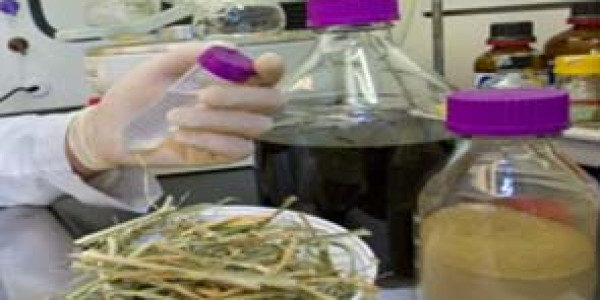Details Category: Technology 16 Aug 2013 Published on Friday, 16 August 2013 The right combination of enzyme cocktail and ionic liquid pretreatment can be used to extract fermentable sugars from switchgrass in a single, wash-free step. (Photo by Roy Kaltschmidt) A “one-pot” method of processing biomass into biofuels has been developed by researchers with the United States Department of Energy’s Joint Bioenergy Institute. “By combining ionic liquid pretreatment and saccharification into a single vessel we eliminate the excessive use of water and waste disposal currently associated with washing biomass that that is pretreated with ionic liquids,” said chemical engineer Blake Simmons. Advanced biofuels made from cellulosic sugars stored in the biomass of grasses and other non-food crops and agricultural waste could substantially reduce the use of fossil fuels. In the United States alone, more than a billion tons of biomass are produced annually that could be potentially used to create cleaner and greener substitutes for fossil fuels. In order for advanced biofuels to be commercially viable however, they must be cost-competitive with fossil fuels. Currently, the processes to extract the sugars needed to formulate these fuels are costly and complicated. To process biomass, it must first be pretreated with an ionic liquid – environmentally benign organic salts – before adding an enzyme cocktail that breaks down the biomass into fermentable sugars. However, as most ionic liquids inhibit the enzyme cocktail, the biomass needs to be washed beforehand. “The recycling and waste disposal costs associated with this required washing pose a significant challenge for the commercial scale-up of ionic liquid pretreatment technology,” said Seema Singh, director of JBEI’s biomass pretreatment program. The JBEI team focused on the use of imidazolium-based molten salts in their one-pot processing method. Imidazolium is one of the most effective known ionic liquids for breaking down cellulosic biomass. “However, imidazolium, like other ionic liquids, can inhibit the commercial enzyme cocktails now used for the saccharification of cellulosic biomass,” said Ms. Singh. To meet this challenge, JBEI researchers developed a compost-derived consortium of bacterium that could grow on switchgrass, a popular biomass crop. The consortium was dubbed “Jtherm” and consists of several species of thermophiles, microbes that can thrive at extremely high temperatures and alkaline conditions. “Jtherm is both an ionic liquid and heat tolerant cellulase cocktail that can liberate sugars from biomass in the presence of up to 20-percent ionic liquids, “ said John Gladden, deputy director for fungal biotechnology at JBEI. The one-pot system uses imidazolium-based ionic liquid pretreatment on the switchgrass then adds Jtherm to extract the sugars. With this one-pot system, they liberated 81.2 percent glucose and 87.4 percent xylose over the course of a 72 hour processing at 70 degrees Celsius. They were able to separate the sugars at better than 90-percent efficiency. The team is now planning to scale-up tests of this one-pot system and is in the process of further optimizing the Jtherm enzyme cocktail and seeking to identify other ionic liquids that could be used in this process. – EcoSeed Staff Taylor Scott International
One-Pot Process To Simplify Production Of Biofuel From Biomass

This entry was posted in Investment, investments, News, Property, Taylor Scott International, TSI, Uk and tagged biomass, chat, combination, friday, ionic, javascript, process, simplify. Bookmark the permalink.







